Snowy Mountains Scheme
| Snowy Mountain Scheme | |
|---|---|
|
Map of Snowy Mountains Scheme | |
| Country | Australia |
| Location | Kosciuszko National Park, New South Wales |
| Coordinates | 36°07′S 148°36′E / 36.12°S 148.6°ECoordinates: 36°07′S 148°36′E / 36.12°S 148.6°E |
| Purpose | Hydroelectricity and irrigation project |
| Status | Operational |
| Construction began | 17 October 1949 |
| Opening date | 21 October 1972 |
| Construction cost | A$820 million |
| Operator(s) | Snowy Hydro Limited |
The Snowy Mountains scheme or Snowy scheme is a hydroelectricity and irrigation complex in south-east Australia. The Scheme consists of sixteen major dams; seven power stations; two pumping stations; and 225 kilometres (140 mi) of tunnels, pipelines and aqueducts that were constructed between 1949 and 1974. The Scheme was completed under the supervision of Chief Engineer, Sir William Hudson and is the largest engineering project undertaken in Australia.[1][2][3]
The water of the Snowy River and some of its tributaries, much of which formerly flowed southeast onto the river flats of East Gippsland, and into Bass Strait of the Tasman sea, is captured at high elevations and diverted inland to the Murray and Murrumbidgee Rivers irrigation areas, through two major tunnel systems driven through the Continental Divide of the Snowy Mountains, known in Australia as the Great Dividing Range. The water falls 800 metres (2,600 ft) and travels through large hydro-electric power stations which generate peak-load power for the Australian Capital Territory, New South Wales and Victoria.[2][4]
In 2016, the Snowy Mountains Scheme was added to the Australian National Heritage List.[5]
History
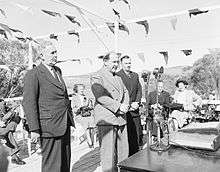
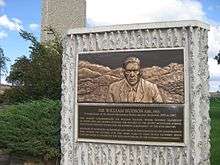
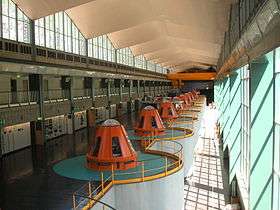
Background
Since the 1830s, both the Murray and Murrumbidgee rivers have been subject to development and control to meet water supply and irrigation needs. By contrast, the Snowy River, that rises in the Australian Alps and flows through mountainous and practically uninhabited country until debouching onto the river flats of East Gippsland, had never been controlled in any way, either for the production of power or for irrigation, and a great proportion of its waters flowed into the sea. The Snowy River has the highest source of any in Australia and draws away a large proportion of the waters from the south-eastern New South Wales snowfields, and was considered a means of supplementing the flow of the great inland rivers, a means for developing hydro-electric power, also a source of increasing agricultural production in the Murray and Murrumbidgee valleys.[2]
Following World War II, the Government of New South Wales proposed that the flow of the Snowy River be diverted into the Murrumbidgee River for irrigation and agricultural purposes; however there was little emphasis placed on the generation of power. A counter proposal by the Government of Victoria involved a greater generation of power, and involved diversion of the Snowy River to the Murray River.[2] Additionally, the Government of South Australia was concerned that downstream flows on the Murray River would be severely jeopardised.[6]
The Commonwealth Government, looking at the national implications of the two proposals, initiated a meeting to discuss the use of the waters of the Snowy River, and a Committee was set up in 1946 to examine the question on the broadest possible basis. This Committee, in a report submitted in November 1948, suggested consideration of a far greater scheme than any previously put forward. It involved not only the simple question of use of the waters of the Snowy River, but consideration of the possible diversion of a number of rivers in the area, tributaries, not only of the Snowy, but of the Murray and Murrumbidgee. The recommendations of the Committee were generally agreed to by a conference of Ministers representing the Commonwealth, New South Wales, and Victoria, and it was also agreed that the Committee should continue its investigations.[2]
However, limitations in the Australian Constitution meant that the Commonwealth Government was limited in the powers it could exercise, without the agreement of the States.[6] Subsequently, the Commonwealth Government introduced legislation into the Federal Parliament under its defence power;[6] and enacted the Snowy Mountains Hydro-Electric Power Act 1949 (Cth) that enabled the formation of the Snowy Mountains Hydroelectric Authority.[2] Ten years later, the relevant States and Territories introduced their own corresponding legislation and in January 1959 the Snowy Mountains Agreement was reached between the Commonwealth and the States.[6]
The legislation created the Snowy Mountains Hydroelectric Authority that was given responsibility for the final evaluation, design and construction of the Snowy Mountains Scheme. The final agreed plan was to divert the waters of the Snowy Mountains region to provide increased electricity generating capacity and to provide irrigation water for the dry west. It was "greeted with enthusiasm by the people of Australia" and was seen to be "a milestone towards full national development".
The chief engineer, New Zealand-born William Hudson[7] (knighted 1955), was chosen to head the scheme as Chairman of the Snowy Mountains Hydroelectric Authority, and was instructed to seek workers from overseas. Hudson's employment of workers from 32 (mostly European) countries, many of whom had been at war with each other only a few years earlier,[8] had a significant effect on the cultural mix of Australia.
Construction
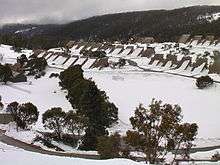

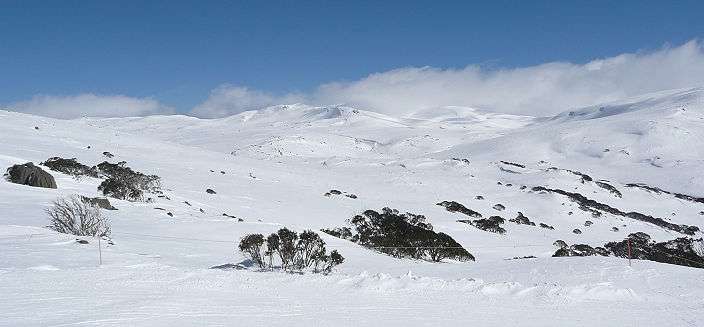
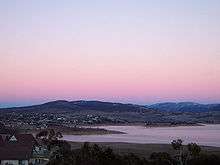

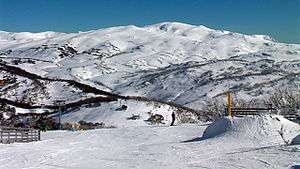
Construction of the Snowy Scheme was managed by the Snowy Mountains Hydroelectric Authority, it officially began on 17 October 1949 and took 25 years, officially completed in 1974.
Tunneling records were set in the construction of the Scheme and it was completed on time and on budget in 1974, at a cost of A$820 million; a dollar value equivalent in 1999 and 2004 to A$6 billion.[9][10][11] Around two thirds of the workforce employed in the construction of the scheme were immigrant workers, originating from over thirty countries. The official death toll of workers on the Scheme stands at 121 people. Some 1,600 kilometres (990 mi) of roads and tracks were constructed, seven townships and over 100 camps were built to enable construction of the 16 major dams, seven hydroelectric power stations, two pumping stations, 145 kilometres (90 mi) of tunnel and 80 kilometres (50 mi) of pipelines and aqueducts. Just 2% of the construction work is visible from above ground.[12]
Two of the towns constructed for the scheme are now permanent; Cabramurra, the highest town in Australia; and Khancoban. Cooma flourished during construction of the Scheme and remains the headquarters of the operating company of the Scheme. Townships at Adaminaby, Jindabyne and Talbingo were inundated by the flooded waters from Lake Eucumbene, Lake Jindabyne and Jounama Reservoir.[13][14][15] Improved vehicular access to the high country enabled ski-resort villages to be constructed at Thredbo and Guthega in the 1950s by former Snowy Scheme workers who realised the potential for expansion of the Australian ski industry.[16][17]
The Scheme is in an area of 5,124 square kilometres (1,978 sq mi), almost entirely within the Kosciuszko National Park. The design of the scheme was modelled on the Tennessee Valley Authority.[11] Over 100,000 people from over 30 countries were employed during its construction, providing employment for many recently arrived immigrants, and was important in Australia's post-war economic and social development. Seventy percent of all the workers were migrants.[1] During construction of the tunnels, a number of railways were employed to convey spoil from worksites and to deliver personnel, concrete and equipment throughout.[18]
The project used Australia's first transistorised computer; one of the first in the world. Called 'Snowcom', the computer was used from 1960 to 1967.[19]
At the completion of the project, the Australian Government maintained much of the diverse workforce and established the Snowy Mountains Engineering Corporation (SMEC), which is now an international engineering consultancy company. The Scheme is the largest renewable energy generator in mainland Australia and plays an important role in the operation of the National Electricity Market, generating approximately 67% of all renewable energy in the mainland National Electricity Market. The Snowy Scheme's primary function is as a water manager, however under the corporatised model must deliver dollar dividends to the three shareholder governments - the NSW, Commonwealth and Victorian Governments.
The Scheme also has a significant role in providing security of water flows to the Murray-Darling Basin. The Scheme provides approximately 2,100 gigalitres (7.4×1010 cu ft) of water a year to the Basin, providing additional water for an irrigated agriculture industry worth about A$3 bn per annum,[1] representing more than 40% of the gross value of the nation's agricultural production.
The Snowy Mountains Hydro-electric Scheme, is one of the most complex integrated water and hydro-electric power schemes in the world and is listed as a "world-class civil engineering project" by the American Society of Civil Engineers.[11] The scheme interlocks seven power stations and 16 major dams through 145 kilometres (90 mi) of trans-mountain tunnels and 80 kilometres (50 mi) of aqueducts. The history of the Snowy Scheme reveals its important role in building post World War II Australia.
Sir William Hudson was appointed the first commissioner of the Snowy Mountains Hydroelectric Authority, serving between 1949 and 1967. The Commissioner's role was the overall management of the Scheme. He represented the Scheme at the highest levels of government, welcomed international scientists and engineers, encouraged scientific and engineering research, as well as attending many social and civic activities. Sir William's management style 'stressed cooperation between management and labour and scientific knowledge (facts) over opinion'.[20]
The Scheme was completed with the official opening of the Tumut 3 Power Station project by the Governor-General of Australia, Sir Paul Hasluck GCMG GCVO KStJ on 21 October 1972.[21]
Current operations
The Scheme is operated by Snowy Hydro Limited, an unlisted public company incorporated pursuant to the Corporations Act, 2001 (Cth), owned by the Governments of New South Wales (58%), Victoria (29%) and Australia (13%).[22]
Environmental concerns
The original plan was for 99% of the water of the Snowy River's natural flow to be diverted by the Scheme below Lake Jindabyne. Releases from the Scheme were based on the needs of only riparian users and took no account of ecosystem needs; it soon became known that the lower reaches of the river were in environmental crisis. An extensive public campaign led to the Snowy Water Inquiry being established in January 1998. The Inquiry reported to the New South Wales and Victorian Governments in October of that year, recommending an increase to 15% of natural flows. The two Governments were equivocal about this target; aside from economic considerations there was a view that the health of the Murray is more important than that of the Snowy and any extra environmental flows are better used there instead.
In the 1999 Victorian state election, the seat of Gippsland East was won by Craig Ingram, an independent and member of the Snowy River Alliance, based in large part on his campaign to improve Snowy flows.[23] In 2000, Victoria and NSW agreed to a long-term target of 28%, requiring A$375 million of investment to offset losses to inland irrigators.[23] In August 2002 flows were increased to 6%, with a target of 21% within 10 years. However, by October 2008 it was evident that the return of environmental flows to the Snowy River in 2009 would be no more than 4% of natural flow with governments arguing the Snowy River needs to "pay back" the "Mowamba Borrowings".[24] At the 2010 state election, Ingram lost the seat of Gippsland East to the Nationals.[25]
Some concerned water managers, conservationists, politicians and farmers continue to advocate for the return of environmental flows to the Snowy River. The Dalgety District and Community Association commemorates Snowy River Day annually, towards the end of August, to mark the 2002 anniversary of when the governments of Victoria, NSW and the Commonwealth first released water into the Snowy River over the Mowamba Weir.[26]
In accordance with the Snowy Water Licence, Snowy Hydro Limited has 're-commissioned' the Mowamba Aqueduct. Seasonal variable flows are essential to river ecology including flushing flows to support vital ecosystems for the Australian platypus[27] and native Australian Bass, the species over which Ingram initially fought for flows into the Snowy River. A major spillway upgrade now facilitates these flows.
Components
Construction of the Scheme began in 1949 and was completed in 1974. Guthega power station commenced power production on 21 February 1955.
Power stations
| Hydro-electric power station | Installed capacity | Year completed |
|---|---|---|
| Guthega | 60 megawatts (80,000 hp) | 1955 |
| Tumut 1 | 330 megawatts (440,000 hp) | 1958 |
| Tumut 2 | 286 megawatts (384,000 hp) | 1961 |
| Blowering | 80 megawatts (110,000 hp) | 1967 |
| Murray 1 | 950 megawatts (1,270,000 hp) | 1967 |
| Murray 2 | 550 megawatts (740,000 hp) | 1969 |
| Tumut 3 | 1,500 megawatts (2,000,000 hp) | 1974 |
| Tumut 3 Micro Hydro | 0.72 megawatts (970 hp) | 2004 |
| Jounama Small Hydro | 14.4 megawatts (19,300 hp) | 2010 |
| Jindabyne Dam Mini Hydro | 1.1 megawatts (1,500 hp) | 2011 |
The total installed capacity is 3.772 gigawatts (5,058,000 hp).
Major dams and reservoirs
The Scheme's largest Dam is Talbingo Dam with an embankment volume of 14 488 000 m3 and a wall height of 161.5 meters.[28] Khancoban Dam is the longest dam in the scheme with a crest length of 1,067 metres (3,501 ft). A variety of dam and spillway types were used in the construction.
With a capacity of 4,798,400 megalitres (1,055.5×109 imp gal; 1,267.6×109 US gal), Lake Eucumbene is the largest reservoir in the Scheme. At the other end of the scale, Deep Creek Reservoir is the smallest reservoir with just 11 megalitres (2.4×106 imp gal; 2.9×106 US gal).[12]
| Dam constructed | Year completed | Impounded body of water | Reservoir capacity | Dam wall height | Crest length | Dam type | Spillway type |
|---|---|---|---|---|---|---|---|
| Blowering Dam | 1968 | Blowering Reservoir | 1,628,000 ML (358×109 imp gal; 430×109 US gal) | 112 m (367 ft) | 747 m (2,451 ft) | Rockfill embankment | Concrete chute |
| Deep Creek Dam | 1961 | Deep Creek Reservoir | 11 ML (2.4×106 imp gal; 2.9×106 US gal) | 21 m (69 ft) | 55 m (180 ft) | Concrete gravity | |
| Eucumbene Dam | 1958 | Lake Eucumbene | 4,798,400 ML (1,055.5×109 imp gal; 1,267.6×109 US gal) | 116 m (381 ft) | 579 m (1,900 ft) | Earthfill embankment | Overflow ski-jump and bucket |
| Geehi Dam | 1966 | Geehi Reservoir | 21,093 ML (4,640×106 imp gal; 5,572×106 US gal) | 91 m (299 ft) | 265 m (869 ft) | Rockfill embankment | Bell Mouth |
| Guthega Dam | 1955 | Guthega Reservoir | 1,604 ML (353×106 imp gal; 424×106 US gal) | 34 m (112 ft) | 139 m (456 ft) | Concrete gravity | Uncontrolled |
| Happy Jacks Dam | 1959 | Happy Jacks Pondage | 271 ML (60×106 imp gal; 72×106 US gal) | 29 m (95 ft) | 76 m (249 ft) | Concrete gravity | Uncontrolled |
| Island Bend Dam | 1965 | Island Bend Pondage | 3,084 ML (678×106 imp gal; 815×106 US gal) | 49 m (161 ft) | 146 m (479 ft) | Concrete gravity | Controlled |
| Jindabyne Dam | 1967 | Lake Jindabyne | 688,287 ML (151,402×106 imp gal; 181,826×106 US gal) | 72 m (236 ft) | 335 m (1,099 ft) | Rockfill embankment | |
| Jounama Dam | 1968 | Jounama Pondage | 43,542 ML (9,578×106 imp gal; 11,503×106 US gal) | 44 m (144 ft) | 518 m (1,699 ft) | Rockfill embankment | Controlled |
| Khancoban Dam | 1966 | Khancoban Reservoir | 26,643 ML (5,861×106 imp gal; 7,038×106 US gal) | 18 m (59 ft) | 1,067 m (3,501 ft) | Earthfill embankment | Controlled |
| Murray Two Dam | 1968 | Murray Two Pondage | 2,344 ML (516×106 imp gal; 619×106 US gal) | 43 m (141 ft) | 131 m (430 ft) | Concrete arch | Controlled |
| Talbingo Dam | 1970 | Talbingo Reservoir | 921,400 ML (202,700×106 imp gal; 243,400×106 US gal) | 162 m (531 ft) | 701 m (2,300 ft) | Rockfill embankment | Concrete chute |
| Tantangara Dam | 1960 | Tantangara Reservoir | 254,099 ML (55,894×106 imp gal; 67,126×106 US gal) | 45 m (148 ft) | 216 m (709 ft) | Concrete gravity | Concrete chute |
| Tooma Dam | 1961 | Tooma Reservoir | 28,124 ML (6,186×106 imp gal; 7,430×106 US gal) | 67 m (220 ft) | 305 m (1,001 ft) | Concrete embankment | |
| Tumut Pond Dam | 1959 | Tumut Pond Reservoir | 52,793 ML (11,613×106 imp gal; 13,946×106 US gal) | 86 m (282 ft) | 218 m (715 ft) | Concrete arch | |
| Tumut Two Dam | 1961 | Tumut Two Pondage | 2,677 ML (589×106 imp gal; 707×106 US gal) | 46 m (151 ft) | 119 m (390 ft) | Concrete gravity |
Pumping Stations
The Snowy Mountains Scheme has two pumping stations. The Jindabyne Pumping Station pumps water from Lake Jindabyne through to the Snowy-Geehi Tunnel at Island Bend.
The pump storage facility at Tumut 3 Power Station returns water to Talbingo Reservoir.[29]
Tourism
The Snowy Scheme is a major tourist destination. Sightseeing driving tours to the key locations of the Scheme are popular out of regional centres like Cooma, Adaminaby and Jindabyne along roads built for the Scheme like the Snowy Mountains Highway and Alpine Way and towards sights like Cabramurra, as Australia's highest town, spectacular dam walls, and scenic lakes. Trout fishing is popular in the lakes of the Scheme, notably Lake Jindabyne and Lake Eucumbene.
The Snowy Scheme Museum opened at Adaminaby in 2011 to profile the history of the Scheme.[30]
Though skiing in Australia began in the northern Snowy Mountains in the 1860s, it was the construction of the vast Snowy Scheme from 1949, with its improvements to infrastructure and influx of experienced European skiers among the workers on the Scheme, that really opened up the mountains for the large scale development of a ski industry, and led to the establishment of Thredbo and Perisher as leading Australian resorts.[16][31] The construction of Guthega Dam brought skiers to the isolated Guthega district and a rope tow was installed there in 1957.[32] Charles Anton, a snowy worker identified the potential of the Thredbo Valley.
See also
References
- 1 2 3 "The Snowy Mountains Scheme". Culture and recreation portal. Department of the Environment, Water, Heritage and the Arts (Australia). 2008. Archived from the original on 30 August 2007. Retrieved 20 July 2008.
- 1 2 3 4 5 6 "The Snowy Mountains Hydro-Electric Scheme". Australian Bureau of Statistics. 23 November 2012. Retrieved 20 October 2012. Check date values in:
|year= / |date= mismatch(help) - ↑ Lewis, Wendy; Balderstone, Simon; Bowan, John (2006). Events That Shaped Australia. New Holland. pp. 189–194. ISBN 978-1-74110-492-9.
- ↑ "The Snowy Mountains Scheme". Technology in Australia 1788-1988. Australian Science and Technology Heritage Centre. 2000. Retrieved 20 October 2012.
- ↑ "Snowy Mountains Hydro-Electric Scheme added to National Heritage List". ABC News. Australian Broadcasting Corporation. 14 October 2016. Retrieved 14 October 2016.
- 1 2 3 4 Bergmann, Michael (February 1999). "The Snowy Mountains Hydro-electric Scheme: How did it Manage Without an EIA?". Australian National University. ISBN 0-7315-3403-4.
- ↑ Sweeney, Brian, ed. (2011). "William Hudson". The New Zealand Edge: Heroes: Builders. IP Holdings Limited. Retrieved 5 May 2013.
- ↑ Sparke, Eric (1996). "Hudson, Sir William (1896–1978)". Australian Dictionary of Biography. National Centre of Biography, Australian National University. Retrieved 20 October 2012.
- ↑ Besley, M. A. (Tim) (11 August 1999). The Need for Infrastructure Projects — Then and Now (Speech). ATSE Focus No 109, November/December 1999. Australian Academy of Technological Sciences and Engineering (ATSE). Retrieved 9 March 2007.
- ↑ Anderson, John (7 June 2004). "AusLink, Peter Garrett, US relations, Iraq, Federal election". Ministers' speeches (Press release). Department of Transport and Regional Services (Australia). Archived from the original (transcript) on 19 September 2006. Retrieved 9 March 2007.
- 1 2 3 "Designated Historic Civil Engineering Landmarks". Heritage Knowledgebase Database. American Society of Civil Engineers. 1997. Retrieved 9 March 2007.
- 1 2 Information plaque, Adaminaby: Snowy Scheme Museum Check date values in:
|access-date=(help); - ↑ "Adaminaby". The Sydney Morning Herald. 1 January 2009. Archived from the original on 6 June 2014.
- ↑ "Towns: Jindabyne". About the Snowy Mountains. Tourism Snowy Mountains. 2012. Retrieved 5 May 2013.
- ↑ "Towns: Talbingo". About the Snowy Mountains. Tourism Snowy Mountains. 2012. Retrieved 5 May 2013.
- 1 2 "History". About Thredbo. Kosciuszko Thredbo Pty Ltd. 2013. Retrieved 20 October 2012.
- ↑ "Guthega". Visit NSW. 24 July 2012. Retrieved 20 October 2012.
- ↑ Wright, H. J.; Shellshear, W. M. (September 1971). "Tunnel Railways of the Snowy Mountains Scheme". Australian Railway Historical Society Bulletin. Australian Railway History: 193–210.
- ↑ "The Engineering". Snowy Mountains Scheme. Snowy Hydro Limited. 2007. Retrieved 20 July 2008.
- ↑ "Investigating, managing, and building the Scheme". Snowy! Power of a nation. Powerhouse Museum. Retrieved 5 May 2013.
- ↑ "Programme for the Official Opening of the Tumut 3 Project". Collection search. National Museum of Australia. 21 October 1972. Retrieved 5 May 2013.
- ↑ "Managing the Snowy". NSW Department of Primary Industries: Office of Water. Government of New South Wales.
- 1 2 Connellan, Ian (November 2010). "Fighting for the Snowy River". Australian Geographic. Retrieved 7 May 2013.
- ↑ Crisp, Louise (3 July 2009). "Snowy River up the creek". Weekly Times. Retrieved 7 May 2013.
- ↑ Mangan, John (28 November 2010). "Nationals end a lone wolf's 11-year run". The Age. Melbourne. Retrieved 7 May 2013.
- ↑ "Dalgety celebrates Snowy River Day". Summit Sun. 16 August 2012. Retrieved 7 May 2013.
- ↑ Snowy River National Park Archived 23 May 2009 at the Wayback Machine.
- ↑ "Dams • Snowy Hydro". Retrieved 2016-10-04.
- ↑ "Pumping Stations • Snowy Hydro". Retrieved 2016-10-04.
- ↑ "Governor-General opens Snowy museum". ABC News. Australia. 17 October 2011. Retrieved 20 October 2012.
- ↑ "The History of Perisher". Perisher Blue Pty Limited. 2013. Retrieved 20 October 2012.
- ↑ "Guthega Ski Resort". Project management. Christiana Capital Group. 2012. Retrieved 20 October 2012.
External links
| Wikimedia Commons has media related to Snowy Mountains Scheme. |
- "New Australia: The Snowy Mountains Hydro-Electric Scheme 1949-1974" (Online exhibition). Migration Heritage Centre of New South Wales. 2011.
- "Our History". Snowy Mountains Engineering Corporation.
- "Power for the People" (36 construction images). Collections: Exhibitions & Events (Permission required). National Archives of Australia. 2009.
- Snowy Hydro Limited
- "Snowy Scheme collection". Collections. National Museum of Australia. 2008.
- "The Snowy Mountains Hydro-electric Scheme". Year Book Australia Special Article. Australian Bureau of Statistics. 1986.
- "The Snowy Mountains Scheme - Australia" (PDF brochure). Snowy Mountains Hydroelectric Authority. University of Technology Sydney.
- The Snowy River Alliance — a community group for the protection of the Snowy River
Further reading
- Collis, Brad (2015). Snowy - The Making of Modern Australia. Canberra, ACT: Coretext Books. ISBN 9780977502936.
- Bevitt, R.; Erskine, W.; Gillespie, G.; Harriss, J.; Lake, P.; Miners, B.; Varley, I. (May 2009). "Expert panel environmental flow assessment of various rivers affected by the Snowy Mountains Scheme" (PDF). NSW Department of Water and Energy. ISBN 978-0-7347-5656-5.
- Failes, Laurence (1965). "Snowy Mountains Hydro Electric Scheme slide collection with accompanying text" (370 slides, digitised and photocopy of typescript). National Library of Australia.
- McHugh, Siobhan (1989). The Snowy - The People behind the Power. Richmond, Victoria: Heinemann. p. 272. ISBN 0-20718-801-7.
.png)